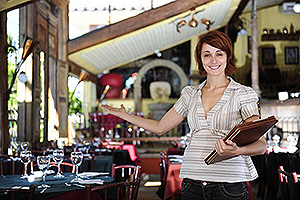
|
Restaurant Operations:
Keeping It Simple - How to Create a Restaurant Concept That Can Succeed
By Brandon O'Dell
High failure rates for restaurants. Yes they’re exagerated, but they’re still high. According to recent studies from several sources, 59-60% of restaurants fail within the first three years. As many as 75% may fail within the first five. Why are they so high? For a list of the six biggest reasons, see The biggest mistakes restaurants make, and why they have a high failure rate.
For the purpose of this article, I’m going to talk about a key fundamental in restaurant concept design, keeping it simple.
 Free Newsletter - Restaurant Marketing, Operations, Service & People Tips... Free Newsletter - Restaurant Marketing, Operations, Service & People Tips...
One can't miss article in each issue!
Sign-up for free and get the very next issue...
Big menus with too many items, oversized dining rooms, multi-ingredient dishes, huge liquor selections and wine lists and over decorating. They’re all symptoms of the same problem, overcomplicating your concept.
As a restaurateur, you may find yourself getting bored with traditional menu items. For you, eating in a restaurant might need to be an adventure. You may have to see or try something you’ve never seen before to be impressed. Very well. I’m the same way.
This may be the underlying factor in why restaurant owners routinely go overboard when designing their concepts. They push their own sensibilities on the general public, not realizing that their tastes are the exception to the rule, and not indicative of the tastes of the public at large. Restaurateurs think they need to present every dish possible to make out of the ingredients they already carry. They think carrying 15 scotches instead of 5 will earn them more customers. If you have a larger selection, you’ll appeal to more people, right? Wrong.
Trying to please everyone leaves you unable to be defined. When you have too many colors in your decor, too many styles of fixtures and furniture, and menu items that represent too many styles of cuisine, your customers find it harder to describe you and recommend you. You find it harder to manage your business effectively and market your brand. You’re trying to stand for too many things at once. Cut out all the extras and keep it simple.
Here’s a short list of things you can do to keep your concept simple.
Choose two contrasting but complementary colors to design your concept around. You may use a third neutral color for accenting, but stay away from unneeded detail and too many extra colors in your scheme. To create a solid brand, you need to be more than attractive, you need to be memorable, and that means keeping your color scheme simple. Use these colors to design your logo, signage, marketing, and to decorated the inside and outside of your restaurant.
Keep your menu small. This serves many purposes, many outlined in my article, Creating a manageable menu. A small menu is easier to control costs on, easier to prepare and order for, and easier to provide consistency with. By having a small menu, your service will be faster, your food quality will be better, and you’ll make more money. Keep your menu simple.
Keep your dining room simple. Smaller dining rooms are easier to manage. If you’re thinking of opening your first restaurant, don’t build a huge dining room with 200 seats. A large dining room takes a large management staff and lots of employees to run. If you find that your 80 seat restaurant gets full every night, then build another one. Don’t worry that you’re not building it big enough.
Keep your market simple. Don’t convince yourself that you want all people of all demographics to like your business. It’s not going to happen. By going after “everyone”, you’ll end up with no one. Even if your style of cooking has mass appeal, your location will determine who is most likely to come into your restaurant. Identify those person’s age, income level, sex, marrital status and religion. They are your target market whether you like it or not. If your concept doesn’t appeal to the people in your area, then you don’t have a feasible concept and you aren’t likely to succeed. Keep your demographic simple and focused.
Keep your menu dishes simple. When you have too many ingredients, and/or too many touches that need to be made to the dish after it’s ordered, before it goes out, you slow down the production of your food. A ticket will only go out as fast as it’s slowest dish. Keep your food simple and easy to produce. Let the ingredients be the stars and don’t loose them in a mish mash of flavors.
Don’t try to carry every liquor any possible customer could want. If you don’t have Glen Fiddich, but you do have five other single malt scotches, any reasonable customer is not going to overlook your restaurant next time because you don’t carry their particular brand, and for the one in 1000 customers who will, so what. It is more important for you to have a manageable inventory and a selection small enough for your staff to become knowledgable on than it is to try and please every customer’s sense of taste. I’ve got a secret for you. Even if you carry 30 different vodkas, you’ll still end up with someone requesting one you don’t have. Keep your liquor and wine selection simple.
While this is the end of this short list, it’s not the end of the application of this fundamental philosophy of restaurant concept design. Any time you have the opportunity to simplify your concept, take it. You’ll end up with something that is simpler to manage, simpler to market, and simpler to turn a profit with.
Brandon O'Dell is the owner of O'Dell Restaurant Consulting - www.bodellconsulting.com
More Restaurant Operations Articles...
Copyright © 1997-2023 Restaurant Report LLC. All rights reserved.
|
|